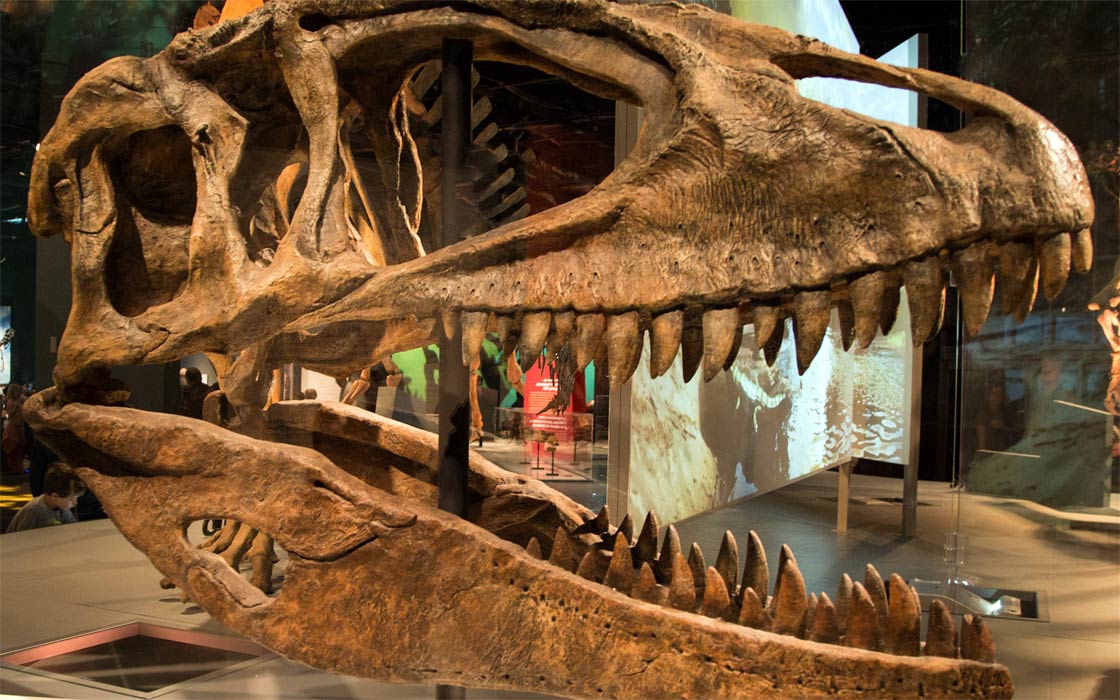Every month, 100,000 readers use the Dinosaur Database, but we receive no support from you. Developing and updating the database requires a lot of work. If you want it to remain open and be updated, please support us via the "Buy us a coffee" button available on every page or via the Support page.
Dinosaur: Carcharodontosaurus saharicus

| Length*: | 12.7 m | 41.7 ft |
| Weight*: | 8 t | 17,637 lb |
*The largest known specimen
Period
Epoch: Early Cretaceous - Late Cretaceous
Stage: Albian-Cenomanian
Years: 113–93.9 Ma
Details
Status: valid
Author: Stromer
Year: 1931
Distribution
Area: Africa
Country: Morocco, Egypt, Algeria
Region: Drâa-Tafilalet, Giza Governorate, Adrar, Ouargla
Formation: Kem Kem Beds, Continental Red Beds, Bahariya, Continental Intercalaire
Description
Carcharodontosaurus saharicus
Carcharodontosaurus saharicus was a massive carnivorous dinosaur that lived during the mid-Cretaceous period, around 100–94 million years ago. Its remains were discovered in North Africa, specifically in the Kem Kem Beds of Morocco and Egypt. The name “Carcharodontosaurus” means “shark-toothed lizard,” reflecting its serrated teeth, which resemble those of the great white shark (Carcharodon carcharias). Carcharodontosaurus was a member of the Carcharodontosauridae family, a group of large theropods that included other giants like Giganotosaurus and Mapusaurus. This dinosaur was among the largest carnivores of its time, dominating the ecosystems of northern Africa.
Physical Characteristics
Carcharodontosaurus saharicus was an enormous predator, estimated to reach lengths of up to 12–13 meters (40–43 feet) and weighing approximately 6–8 metric tons. Its skull was massive, around 1.6 meters (5.2 feet) long, housing large, blade-like teeth that were serrated along their edges, perfect for slicing through flesh. The skull also featured strong jaw muscles that could deliver a powerful bite, although it likely relied more on inflicting deep, slashing wounds than crushing bones. Its body was built for speed and power, with a long, muscular tail that provided balance and agility. The forelimbs were relatively short but strong, with three fingers ending in sharp claws, while the hind limbs were robust, supporting a powerful, upright stance.
Diet and Feeding Habits
Carcharodontosaurus saharicus was a hypercarnivore, preying on large herbivorous dinosaurs such as sauropods and ornithopods that shared its habitat. Its teeth, which could reach lengths of up to 20 centimeters (8 inches), were adapted for slicing through flesh rather than bone, suggesting it used its sharp teeth to tear into its prey and consume large chunks of meat. The structure of its teeth and skull indicates that Carcharodontosaurus likely targeted soft tissue, using a powerful head and neck to deliver strong, slashing bites. As one of the top predators of its time, it would have played a crucial role in controlling the populations of large herbivores in its ecosystem.
Habitat and Distribution
Carcharodontosaurus saharicus lived in what is now North Africa, particularly in regions that were part of the Kem Kem Group, a rich fossil site that extends across modern-day Morocco, Algeria, and Egypt. During the mid-Cretaceous period, this area was a vast river delta with numerous lakes, swamps, and floodplains. The environment was warm and humid, supporting diverse vegetation such as ferns, conifers, and flowering plants. These conditions provided an ideal habitat for large herbivores, which in turn attracted apex predators like Carcharodontosaurus. The lush, riverine environment was likely teeming with life, offering ample hunting opportunities for this large predator.
Behavior and Social Structure
The behavior of Carcharodontosaurus saharicus remains largely speculative due to the limited fossil evidence, but as a large theropod, it was likely a solitary hunter, though it may have come together with others of its kind for breeding or during periods of abundant prey. Its size and strength would have made it difficult for other predators to challenge, suggesting it was at the top of the food chain in its environment. Some paleontologists hypothesize that Carcharodontosaurus may have engaged in territorial behavior, particularly during mating seasons or when resources were scarce. Fossil evidence of other large theropods suggests they may have been opportunistic feeders, scavenging when necessary, and Carcharodontosaurus likely followed similar patterns.
Discovery and Research
Carcharodontosaurus saharicus was first discovered in the 1920s, with initial remains described by German paleontologist Ernst Stromer in 1931. Unfortunately, many of these original fossils were destroyed during World War II. Later, in the 1990s, additional fossils were discovered in Morocco, including skull fragments and teeth, which allowed paleontologists to further study this giant predator. Research on Carcharodontosaurus continues to evolve as new discoveries are made, providing more insights into its anatomy, behavior, and ecology. Advances in technology, such as CT scanning and biomechanical modeling, have also helped scientists reconstruct its skull and understand how it might have hunted and fed.
Significance and Interesting Facts
Carcharodontosaurus saharicus is significant for several reasons. It was one of the largest known predatory dinosaurs, rivaling the size of Tyrannosaurus rex and Giganotosaurus. Its discovery has been crucial for understanding the diversity and distribution of large theropods during the Cretaceous period. The presence of Carcharodontosaurus in North Africa also highlights the complex predator-prey dynamics of the region, which featured multiple large carnivores, each occupying a slightly different ecological niche. The study of Carcharodontosaurus contributes to our broader understanding of carcharodontosaurid evolution and how these large predators adapted to different environments across what is now South America, Africa, and Europe.
Locations
Sources
Material: Partial skeleton (destroyed), incomplete skull and referred many teeth and bones.
References: Brusatte, S.L. and Sereno, P.C. (2007). "A new species of Carcharodontosaurus (dinosauria: theropoda) from the Cenomanian of Niger and a revision of the genus.




